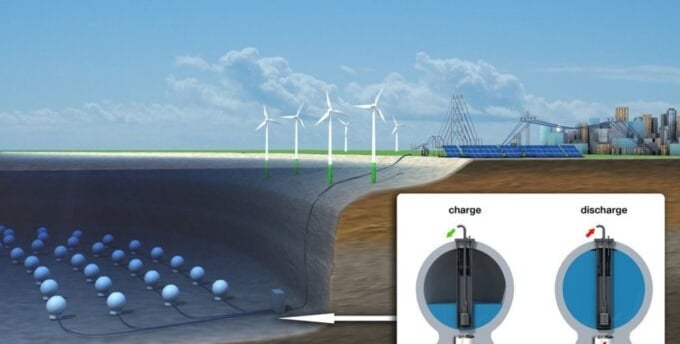Underwater Concrete Sphere Batteries Could Revolutionize Renewable Energy Storage
A new technology is being tested off the coast of California using submerged concrete spheres as batteries to store renewable energy. This solution promises a sustainable, efficient, and environmentally friendly alternative to traditional energy storage methods.
TECHNOLOGY
Team Spark Tech
5/2/20253 min read


Innovative Technology Uses Concrete Spheres as Underwater Batteries for Renewable Energy Storage
As the world searches for cleaner and more sustainable ways to store energy, a groundbreaking technology is gaining attention for its innovation and environmental benefits. Scientists and engineers are testing a system that transforms submerged concrete spheres into high-efficiency energy storage batteries. The project, currently being developed and tested off the coast of California, could significantly change how we store renewable energy like solar and wind power.
How Do These Underwater Batteries Work?
The technology is based on simple physics—gravity and hydrostatic pressure. Hollow concrete spheres, ranging from two to four meters in diameter, are placed on the ocean floor. These structures function as compressed air-based energy storage systems.
The process has two main stages:
Energy Storage: When there is a surplus of renewable energy (such as during peak solar hours), the energy is used to pump water out of the spheres, compressing the air inside them.
Energy Generation: When energy is needed, seawater flows back into the spheres, pushing the compressed air through turbines to generate electricity.
The ocean’s depth provides the pressure needed for the turbines to function efficiently, making the system clean, quiet, and highly durable.
Advantages of This Technology
Concrete sphere underwater batteries offer several benefits over traditional lithium-ion battery storage systems:
Sustainability: Concrete is widely available and recyclable. The system uses no heavy metals or toxic chemicals.
Low Environmental Impact: Submerged on the seabed, the spheres occupy no land space and have minimal impact on marine ecosystems.
Durability: Underwater systems experience less physical wear and can last for decades with minimal maintenance.
Competitive Cost: Although initial installation costs are high, low maintenance and operational expenses make the system economically viable in the long term.
Ongoing Testing in California
The project is being tested off the California coast, led by researchers and engineers from the Massachusetts Institute of Technology (MIT), in partnership with renewable energy companies. According to the team, early tests show promising results, with consistent storage capacity and performance exceeding expectations.
California’s ocean depths—reaching over 500 meters just a few kilometers offshore—offer ideal conditions for this technology, enhancing compression efficiency and power generation.
A Viable Alternative to Traditional Energy Storage
Energy storage is one of the biggest challenges in the global transition to renewable energy. Solar and wind are intermittent sources, meaning they don’t produce energy consistently. That’s where batteries come in.
Currently, most large-scale energy storage relies on chemical batteries, which have several limitations:
Relatively short lifespan (around 10 years)
Environmental risks from heavy metal waste
Dependence on raw materials like lithium and cobalt, whose extraction harms the environment and communities
Concrete sphere batteries present a clean, scalable alternative that can complement or even replace chemical batteries in certain applications.
Global Expansion Potential
The technology is versatile and can be deployed in various parts of the world, provided there is sufficient ocean depth and the infrastructure to connect the system to the electrical grid.
Promising regions include:
The North Sea (Europe)
The coast of Japan
Australia
South America (especially Chile and Brazil)
This system could also support energy needs in isolated coastal communities, which often face challenges in securing reliable electricity.
Challenges and Next Steps
While promising, the technology must still overcome a few hurdles before large-scale adoption:
Subsea Infrastructure: Requires robust technology for underwater installation and maintenance.
Initial Costs: Upfront investment remains high but could decrease with scale.
Environmental Regulation: Ensuring minimal marine ecosystem disruption is essential and must be carefully monitored.
Researchers aim to expand testing with varying depths, turbine types, and advanced materials. If results continue to improve, commercial deployment is expected by the end of this decade.
A More Sustainable Future
Energy storage technologies are critical to the global energy transition. As the world moves toward sustainability, innovation plays a central role.
Submerged concrete spheres are more than a scientific novelty—they could become a key part of a more resilient, accessible, and eco-friendly energy system.
With advanced testing and promising results, this technology could help solve one of today's greatest challenges: storing energy efficiently, cleanly, and sustainably.
Source: MIT News
Photo by x.com/HOCHTIEF_AG
Read More...
News
Stay up to date with the latest technological news, Science, Internet, Social Networks and Smartphones.
© 2025. All rights reserved.
